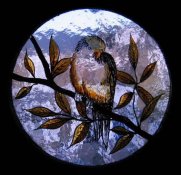holmburgers
Member
There are glass casting methods that use plaster molds for pouring molten glass into various forms. I would like to apply this to the making of photographs composed completely of glass. Ultimately with the idea of making incredibly unique and potentially beautiful stained glass "prints".
A photographic relief image can be formed in plaster by taking a high-relief carbon print/matrix, swelling it to full size w/ water and impressing this upon wet plaster. The result is a permanent and durable mold that can, in theory, withstand the high temperatures required for glass casting.
F.E. Ives early halftone process utilized a plaster mold of this type, proving that a usable relief image in plaster can be made in this way (the carbon method).
Imagine now pouring glass into this mold and with some kind of "doctor blade" skimming the excess from the mold, leaving colored glass in the valleys of the relief image in direct proportion to their density in the original photograph. Upon drying, a layer of gelatin, collodion, CMC gum or any number of colloids could be poured over this, allowed to dry and used to lift the glass image from the mold without disrupting its distribution. This could potentially be transferred to another surface, or might constitute the final mount. Ideally, several layers could be combined, possibly by glass fusing methods.
The viscosity of molten glass is my biggest concern for this method working. All glass pouring I have seen looks like cold honey at best; highly viscous. It seems reasonable to assume that a much lower viscosity would be required to allow the glass to occupy every nook & cranny of the plaster relief, and also to allow for easy "skimming" of the excess.
Alternatively, perhaps there is a method that would allow etching of glass to such a degree as to make relief images directly in glass. Hydrofluoric acid, sodium hydroxide and perhaps other chemicals will dissolve glass.
Has there ever been a method of reproducing continuous tone photographs in glass?, that is, not some kind of half-tone process & etch, or a process where an image is applied to the glass. The glass, which in any kind of relief scheme has to be inpregnated with a colourant, must be the photograph, not a substrate.
Glass experts? Process history savants?
A photographic relief image can be formed in plaster by taking a high-relief carbon print/matrix, swelling it to full size w/ water and impressing this upon wet plaster. The result is a permanent and durable mold that can, in theory, withstand the high temperatures required for glass casting.
F.E. Ives early halftone process utilized a plaster mold of this type, proving that a usable relief image in plaster can be made in this way (the carbon method).
Imagine now pouring glass into this mold and with some kind of "doctor blade" skimming the excess from the mold, leaving colored glass in the valleys of the relief image in direct proportion to their density in the original photograph. Upon drying, a layer of gelatin, collodion, CMC gum or any number of colloids could be poured over this, allowed to dry and used to lift the glass image from the mold without disrupting its distribution. This could potentially be transferred to another surface, or might constitute the final mount. Ideally, several layers could be combined, possibly by glass fusing methods.
The viscosity of molten glass is my biggest concern for this method working. All glass pouring I have seen looks like cold honey at best; highly viscous. It seems reasonable to assume that a much lower viscosity would be required to allow the glass to occupy every nook & cranny of the plaster relief, and also to allow for easy "skimming" of the excess.
Alternatively, perhaps there is a method that would allow etching of glass to such a degree as to make relief images directly in glass. Hydrofluoric acid, sodium hydroxide and perhaps other chemicals will dissolve glass.
Has there ever been a method of reproducing continuous tone photographs in glass?, that is, not some kind of half-tone process & etch, or a process where an image is applied to the glass. The glass, which in any kind of relief scheme has to be inpregnated with a colourant, must be the photograph, not a substrate.
Glass experts? Process history savants?














